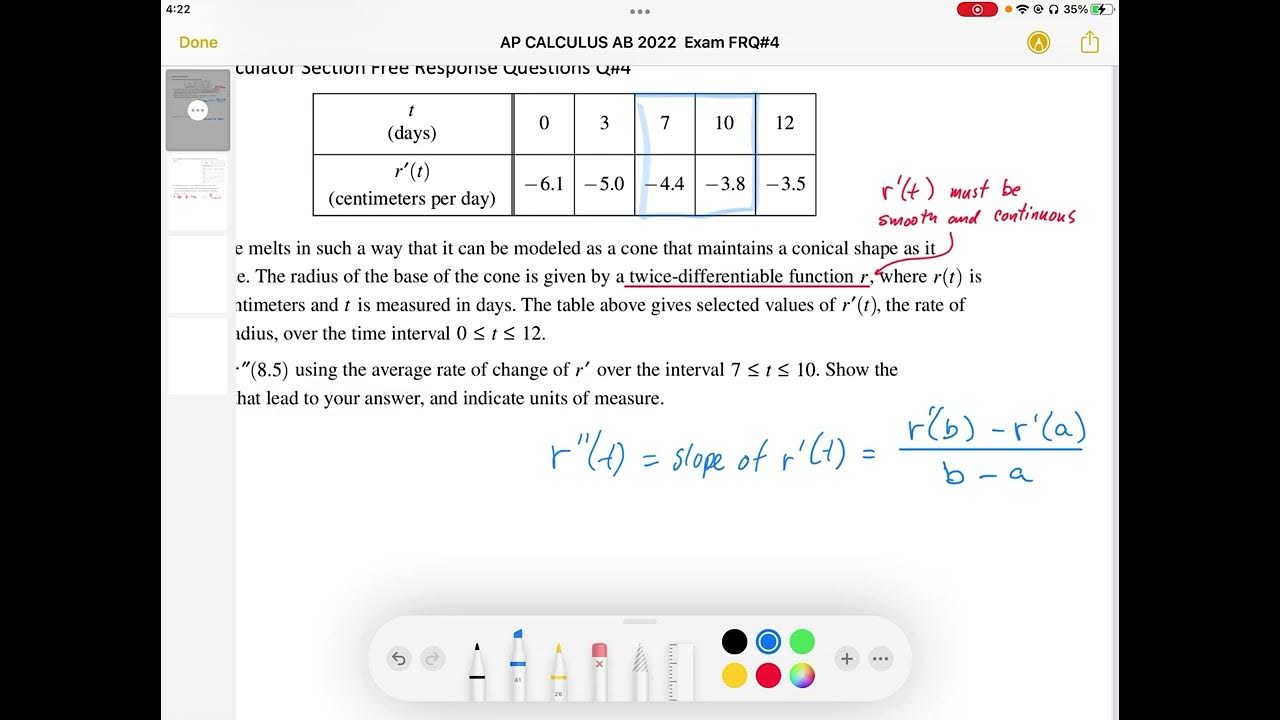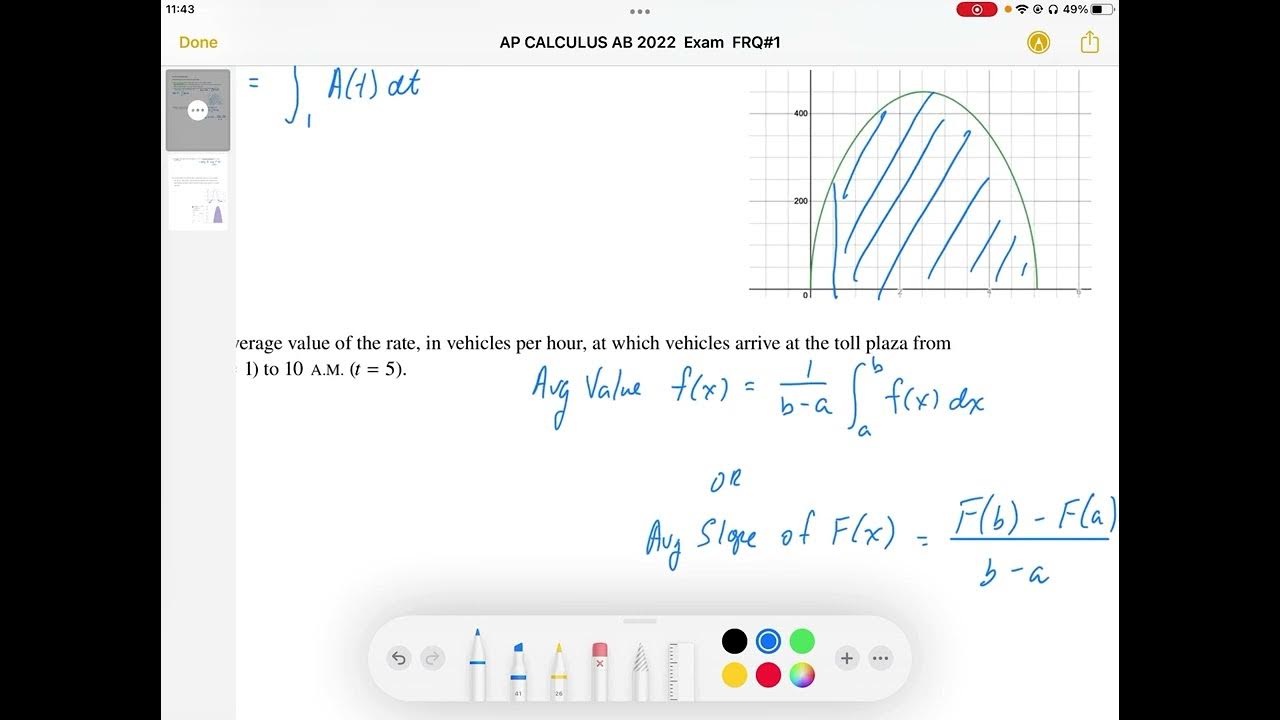Calculus BC 2008 2d | AP Calculus BC | Khan Academy
TLDRThe video script discusses a mathematical problem involving the rate of ticket sales over time, modeled by a function r(t) = 550te^(-t/2). The focus is on determining the total number of tickets sold by 3:00 PM. The solution is found using the concept of definite integrals from calculus, representing the area under the curve of the rate function. By applying the fundamental theorem of calculus and using a graphing calculator, the problem is efficiently solved, resulting in an approximate of 973 tickets sold by the specified time.
Takeaways
- 📈 The script discusses a mathematical model for the rate of ticket sales over time.
- 🧮 The model is given by the function r(t) = 550te^(-t/2) tickets per hour.
- 🕒 The task is to determine the number of tickets sold by 3:00 PM.
- 📌 The importance of rounding the answer to the nearest whole number is emphasized.
- 🌟 The concept of the derivative is introduced as the rate of change in the number of tickets sold.
- 📚 The total number of tickets sold is found using the definite integral of the rate function.
- 🧠 The integral is represented as ∫ from 0 to t of 550te^(-t/2) dt.
- 📊 The use of a graphing calculator for efficient computation of definite integrals is suggested.
- 🔢 The calculation yields an approximate value of 972.78 tickets sold by 3:00 PM.
- 📐 Rounding the result gives the final answer of 973 tickets sold.
- ⏰ The process is time-efficient, taking only a few minutes with the aid of a calculator.
Q & A
What is the main topic of discussion in the script?
-The main topic of discussion is the mathematical modeling of the rate at which tickets were sold over a certain period and how to calculate the number of tickets sold by a specific time using calculus.
What is the function given to model the rate of ticket sales?
-The function given to model the rate of ticket sales is r(t) = 550te^(-t/2) tickets per hour.
Why is it important to round the answer to the nearest whole number when calculating ticket sales?
-It is important to round the answer to the nearest whole number because ticket sales are typically counted in whole numbers, and decimals do not represent real-world ticket transactions.
What does the 'r of t' in the script represent?
-The 'r of t' represents the rate at which tickets were sold at time 't'.
How does the script suggest solving the integral for the number of tickets sold by 3:00 PM?
-The script suggests using a graphing calculator to compute the definite integral from 0 to 3 for the function 550te^(-t/2) to find the number of tickets sold by 3:00 PM.
What is the significance of the definite integral in this context?
-The definite integral represents the accumulated number of tickets sold between time equals 0 and a specific time 't'. It is the area under the curve of the rate function over that time interval.
What is the result of the calculation for the number of tickets sold by 3:00 PM?
-The result of the calculation is 972.78, which rounds to approximately 973 tickets sold by 3:00 PM.
How long does it take to solve this problem using a graphing calculator?
-The script suggests that it takes about four minutes to solve the problem using a graphing calculator.
What is the relevance of the fundamental theorem of calculus in this problem?
-The fundamental theorem of calculus is used here to relate the rate at which tickets are sold (the derivative) to the total number of tickets sold (the integral). It allows us to calculate the total number of tickets sold over a time interval by integrating the rate function.
Why is the graphing calculator an efficient tool for solving this problem?
-The graphing calculator is an efficient tool for solving this problem because it can quickly and accurately compute the definite integral, which would be time-consuming to do manually.
How does the script demonstrate the process of using the graphing calculator?
-The script demonstrates the process by showing the steps of entering the integral function, replacing 't' with 'x', setting the limits of integration from 0 to 3, and then using the calculator to find the result.
Outlines
📈 Mathematical Modeling of Ticket Sales
The paragraph discusses a mathematical model for the rate of ticket sales over a specific time range. The model is given by the function r(t) = 550te^(-t/2), representing the number of tickets sold per hour. The goal is to determine the total number of tickets sold by 3:00 PM. The speaker explains that the total tickets sold can be found using the definite integral of the rate function from time 0 to 3, which represents the area under the curve of the rate function. The speaker also mentions that while the integral can be solved analytically, it is more efficient to use a graphing calculator to find the numerical answer, which is rounded to the nearest whole number. The final answer provided is 973 tickets sold by 3:00 PM.
Mindmap
Keywords
💡transcript
💡integral
💡rate
💡tickets sold
💡calculus
💡definite integral
💡graphing calculator
💡function
💡time
💡rounding
💡problem-solving
Highlights
The discussion begins with the intention to complete part D of a task.
The speaker decides that a graph is not necessary and removes it efficiently.
A mathematical model, r(t) = 550te^(-t/2), is introduced to represent the rate of ticket sales.
The goal is set to determine the number of tickets sold by 3:00 PM using the model.
The importance of providing whole number answers for practical applications is emphasized.
The concept of the derivative as the rate of change in the total number of tickets sold is explained.
The fundamental theorem of calculus is referenced as a basis for calculating the total number of tickets sold.
An integral of the rate function, ∫(550te^(-t/2)dt) from 0 to t, is used to find the total tickets sold.
The definite integral represents the area under the curve of the rate function from time 0 to 3.
The analytical solution of the integral is briefly mentioned using integration by parts.
The use of a graphing calculator for efficient computation of definite integrals is recommended.
The calculation process using a graphing calculator is described in detail.
The result of the calculation, 972.78 tickets, is obtained using the calculator.
The final answer is rounded to the nearest whole number, resulting in 973 tickets.
The efficiency of using a calculator is highlighted, saving significant time over manual integration.
The task is completed in a short time, demonstrating the practical application of the method.
Transcripts
5.0 / 5 (0 votes)
Thanks for rating:





